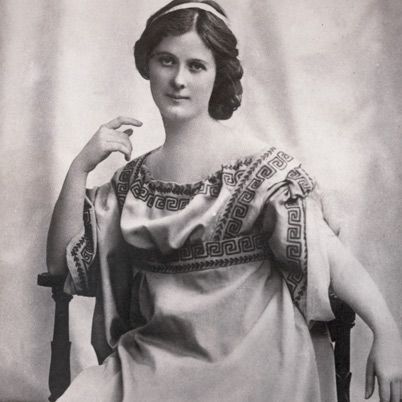You are viewing the article Isadora Duncan at Lassho.edu.vn you can quickly access the necessary information in the table of contents of the article below.

(1877-1927)
Who Was Isadora Duncan?
Isadora Duncan developed an approach to dance that emphasized naturalistic movement. She was a hit in Europe as a performer to classical music and opened schools that integrated dance with other types of learning. She later faced immense tragedy with the death of her children and spouse’s suicide.
Childhood
With accounts varying, Isadora Angela Duncan was born circa May 26, 1877 (the date on her baptismal certificate; some sources say May 27, 1878), in San Francisco, California. Her parents divorced when Duncan was an infant, and she was raised by her mother, Dora, a piano teacher with a great appreciation for the arts. At the age of 6, Duncan began to teach movement to little children in her neighborhood; word spread, and by the time she was 10, her classes had become quite large. She requested to leave public school so that she, along with older sister Elizabeth, could earn income from teaching. Duncan subsequently received tutelage from poet Ina Coolbrith.
Success in Europe
Duncan lived in Chicago and New York before moving to Europe. There with brother Raymond she studied Greek mythology and visual iconography, which would inform her sensibilities and general style of movement as an artist. Duncan came to look at ancient rituals around dance, nature and the body as being central to her performance ideology.
Barefoot and clad in sheaths inspired by Greek imagery and Italian Renaissance paintings, Duncan danced her own choreography in the homes of the financially elite before becoming a major success in Budapest, Hungary, having a sold-out run of shows in 1902.
She embarked on successful tours, becoming a European sensation honored not only by enraptured audiences, but by fellow artists who captured her image in painting, sculpture and poetry. Duncan’s style was controversial for its time, as it defied what she viewed as the constricting conventions of ballet, placing major emphasis on the human female form and free-flowing moves. Duncan’s achievements and artistic vision would lead her to be called the “Mother of Modern Dance”—a moniker also shared by a successor of sorts, Martha Graham.
Schools and ‘Isadorables’
Duncan defied social custom in other ways and was viewed as an early feminist, declaring that she wouldn’t marry and thus having two children out of wedlock. Duncan also founded dance schools in the United States, Germany and Russia, with her dance students dubbed the “Isadorables” by the media. She developed a particularly affinity for the latter country and its revolutionary movements, and in the early 1920s received patronage from Vladimir Lenin for her teaching work.
Difficult Personal Life
Duncan faced horrific tragedies in her life, with her two children and their nanny drowning in 1913 when the car they were in fell into the Seine River. Later, Duncan married poet Sergey Aleksandrovich Yesenin in 1922, favoring a legal union to allow him travel to the United States. However, the couple was ostracized due to anti-Bolshevik paranoia, and Duncan declared that she would not return to America. The marriage wouldn’t last, with Yesenin suffering from severe mental health issues and committing suicide in the mid-1920s.
Duncan struggled emotionally during her later years. She died in Nice, France, on September 14, 1927, when her scarf got caught in the back wheels of an automobile in which she was riding.
The same year of her death, Duncan’s autobiography was published, My Life, which has gone on to become a critically acclaimed work. Over the years, many other books, along with several films, have offered accounts on Duncan’s life and art.
QUICK FACTS
- Name: Isadora Duncan
- Birth Year: 1877
- Birth date: May 26, 1877
- Birth State: California
- Birth City: San Francisco
- Birth Country: United States
- Gender: Female
- Best Known For: Isadora Duncan was a trailblazing dancer and instructor whose emphasis on freer forms of movement was a precursor to modern dance techniques.
- Industries
- Art
- Writing and Publishing
- Music
- Theater and Dance
- Astrological Sign: Gemini
- Death Year: 1927
- Death date: September 14, 1927
- Death City: Nice
- Death Country: France
Fact Check
We strive for accuracy and fairness.If you see something that doesn’t look right,contact us!
CITATION INFORMATION
- Article Title: Isadora Duncan Biography
- Author: Biography.com Editors
- Website Name: The Biography.com website
- Url: https://www.biography.com/artists/isadora-duncan
- Access Date:
- Publisher: A&E; Television Networks
- Last Updated: July 28, 2020
- Original Published Date: April 2, 2014
QUOTES
- My art is just an effort to express the truth of my Being in gesture and movement. It has taken me long years to find even one absolutely true movement.
- She is coming, the dancer of the future: the free spirit, who will inhabit the body of new women; more glorious than any woman that has yet been; more beautiful than all women in past centuries: The highest intelligence in the freest body.
- Far from wishing to develop theatre dancers, I have only hoped to train in my school numbers of children who through dance, music, poetry and song would express the feelings of the people, with grace and beauty.
- The true dance is an expression of serenity; it is controlled by the profound rhythm of inner emotion. Emotion does not reach the moment of frenzy out of a spurt of action; it broods first, it sleeps like the life in the seed, and it unfolds with a gentle slowness.
Thank you for reading this post Isadora Duncan at Lassho.edu.vn You can comment, see more related articles below and hope to help you with interesting information.
Related Search: